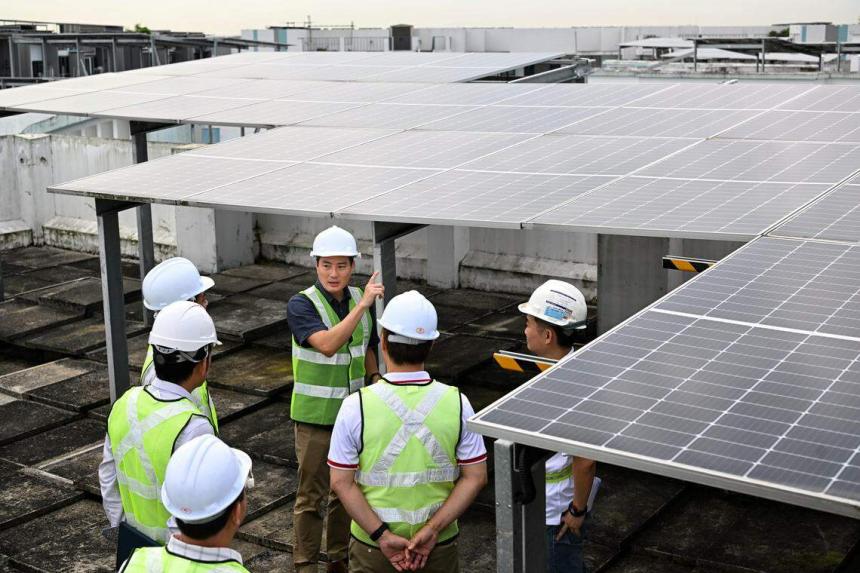SINGAPORE – Solar panels are set to be installed at up to 1,075 Housing Board blocks by the third quarter of 2026, as part of Singapore’s drive to harness more clean energy. This will bring the number of blocks slated to have solar panels to about 9,500.
HDB said on Thursday that it aims to install solar panels on as many of the more than 10,000 blocks islandwide as possible over the next three years.
Energy generated from solar panels is used to power common services like lifts, lights and water pumps in the daytime. Excess solar energy is channelled to the electrical grid.
The latest blocks to be fitted with the panels are in Aljunied-Hougang, Nee Soon and Sengkang.
Another 104 government sites – including 55 primary and secondary schools, Khoo Teck Puat Hospital Tower B and the Ministry of Foreign Affairs headquarters – will also have such panels installed under the latest tender launched on Wednesday.
With a solar capacity of 113 megawatt-peak (MWp) – equivalent to powering 28,250 four-room HDB flats – Wednesday’s tender is the largest to date under the Government’s SolarNova programme. The programme compiles the demand for solar energy from various agencies and is jointly led by HDB and the Economic Development Board.
On average, HDB blocks with solar panels can achieve net-zero energy consumption in common areas, which means the energy used by the building is roughly equal to the amount of energy it produces.
HDB said in a statement that the latest and eighth tender will bring its total solar capacity to 440MWp, the equivalent of powering 110,000 four-room flats.
To date, about 3,300 HDB blocks have been fitted with solar panels.
The board also announced a new initiative to further reduce energy consumption in HDB estates by recovering energy generated when lifts are moving and braking. The Elevator Energy Regeneration System will use the energy recovered to power other services within the lift such as lighting, ventilation and the display panel. It can reduce lift energy consumption by an average of 20 per cent, said HDB.
It added that the system will be installed in existing HDB lifts where feasible. HDB is targeting to call the first tender in the fourth quarter of 2023. This will cover about 4,000 lifts, with retrofitting expected to start in 2024 and be completed in about five years.
Senior Minister of State for National Development Tan Kiat How, who on Thursday visited an HDB block in Sengkang with solar panels installed, said the latest SolarNova tender is part of the board’s plan to achieve its solar target of 540MWp by 2030.
Singapore aims to generate 2 gigawatt-peak (GWp) of solar energy by 2030 – of which 1.5GWp will be rolled out by 2025 – under its national green plan.
Mr Tan said the SolarNova programme will give industries certainty in terms of the scale of solar panel installation, “allowing them to drive the cost down and generate excess electricity to sell back to the grid”. “So it’s a win-win outcome for Singaporeans and for climate change ambitions.”
Other sustainability efforts spearheaded by HDB include installing 2,000 electric vehicle charging points in over 700 HDB carparks by the end of 2023, ensuring that one in three HDB carparks has such charging points.
Also, an estimated 15 UrbanWater Harvesting Systems will be installed in 89 blocks in Jurong and Yishun from 2027. These systems capture rainwater to wash common areas and water plants in the estates.
Other government agencies such as national water agency PUB and JTC Corporation have planned their own solar initiatives too.
PUB announced in August 2021 that it had identified Lower Seletar Reservoir and Pandan Reservoir as sites for two large-scale floating solar farms, which could potentially produce 100MWp and 44MWp of power, respectively.
Statutory board JTC launched a tender in January to install solar panels on temporarily vacant land and rooftops on Jurong Island, and on dead sea space off the island. Collectively, these panels will cover about 5 per cent of Singapore’s solar target by 2030.
Correction note: An earlier version of this article said solar panels will be installed at another 1,075 HDB blocks by the third quarter of 2026. HDB has clarified that solar panels may not be installed at all 1,075 blocks covered under the tender, as actual installation will be determined based on the feasibility assessment of site conditions of each block.


